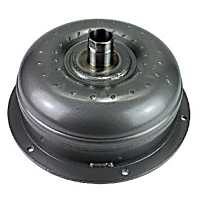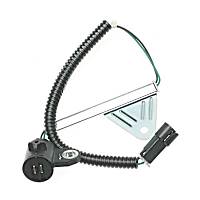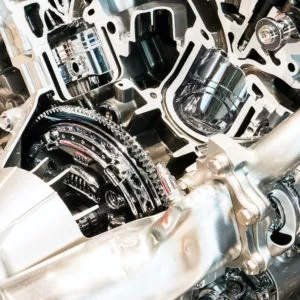Your vehicle is equipped with many sensors to monitor the different components of your engine and transmission. Along with your vehicle’s primary computer (powertrain control module or PCM), they work together to help various parts of your vehicle to operate correctly. One of these sensors is called an input speed sensor or turbine speed sensor.
What happens when your vehicle’s PCM detects a potential fault with this sensor? In this article, you will learn more about code P0715, a diagnostic trouble code (DTC) related to your input turbine speed sensor.
What Does the P0715 Code Mean?
Diagnostic Trouble Code (DTC) P0715 stands for Input/Turbine Speed Sensor “A” Circuit. To put it simply, this code is triggered when your vehicle’s PCM detects an irregularity in the signal sent by the input speed sensor in the transmission.

Error code P0715 is a generic trouble code, so it is supported in various makes and models. However, keep in mind that the repair and diagnostic procedures for each may vary depending on the specific vehicle you own.
To understand the code more, we have to discuss the basics of an input speed sensor.
P0715 on Some Ford Vehicles
Code P0715 may appear on some Ford vehicles like the 2015 Ford F-150 XL 3.5L V6.
For this specific Ford vehicle, it is recommended to use a scan tool and check first if related DTCs like the P0717 code are present. If the P0715 returns after clearing P0717, go to Pinpoint Test D.

More About Input Speed Sensors
Located on or inside your vehicle’s transmission, the turbine speed sensor measures the RPM of the turbine shaft. Once the PCM or TCM detects an irregularity in the turbine speed input, it will trigger the illumination of the Check Engine Light.
A vehicle may go into “fail-safe” mode as a result of this trouble code. This is a condition where the vehicle’s power and speed are suppressed to avoid further damaging other components.
For an advanced technical description of the turbine and how turbine shaft speed is monitored, you can choose to read our detailed explanation here.
If you want to learn the possible causes of P0715, read the next section.
What are the Possible Causes of the P0715 Code?
There can be several triggers of this code. Here are some of them:
- Faulty Input/Turbine Speed Sensor
- Faulty Output Speed Sensor
- Failing Torque Converter
- Damaged sensor wiring
- Damaged or broken reluctor ring/shaft
- An internal transmission issue
What are the Common Symptoms of the P0715 Code?
Aside from the check engine light, here are other common symptoms you should watch for:
- Vehicle in “fail-safe condition”
- Abnormal transmission operation
- Decreased fuel economy
How to Diagnose the P0715 Code
It may be difficult to diagnose and pinpoint the exact cause of this code. If you’re not confident that you can do this on your own, you can always ask your trusted mechanic to do the diagnostic procedures for you.
However, if you’re equipped with the DIY automotive skills needed, here is a video you can watch to help you understand the code more:
How to Fix the P0715 Code
P0715 is a generic code and it is supported in various makes and models. However, there is no single fix for the code. This may vary depending on your vehicle’s make and model. For example, repair procedures for a P0175 in Chevy may vary from a P0175 in Ford.
If you’re not that familiar with auto repair, it is best to leave the job to trusted professionals.
What is the Turbine?
The torque converter has three primary parts. The outer shell of the torque converter is thick, heavy steel and the front of the converter is bolted to the engine flex plate, which in turn is bolted to the crankshaft so that as the plate spins, so does the torque converter shell.
The rear side of the torque converter’s outer shell has a hollow insert with two flats or two notches that engage the rotor inside the transmission fluid pump so that as the engine spins the torque converter shell, it also spins the transmission fluid pump, which supplies transmission fluid to the inside cavity of the torque converter as well as to the valve body, which delivers pressure to selectively apply the clutches and bands. The heart of the automatic transmission is a planetary gearset (simple or compound), which provides the various gear ratios, depending on which parts of the gearset are held or driven.

The outside surface of the torque converter’s pump drive insert is polished so that as it spins, the pump seal will prevent fluid leakage from the transmission.
Inside the rear surface of the torque converter shell there are vanes, much like you see in a jet engine, and as the engine spins the fluid pump, transmission fluid fills the torque converter. The vanes fixed to the inside rear of the converter shell always spin at engine speed; this part of the torque converter is referred to as the “impeller.”
The impeller vanes, as they spin, throw fluid against a similarly sized set of vanes on a separate, inner component of the converter the vanes angled differently. This component is the turbine, which spins freely within the torque converter shell, but is splined to the transmission input shaft, which is also called the “turbine shaft.”
The impeller vanes, as they spin, throw fluid against a similarly sized set of vanes on a separate, inner component of the converter the vanes angled differently. This component is the turbine, which spins freely within the torque converter shell, but is splined to the transmission input shaft, which is also called the “turbine shaft.”
–Richard McCuistian, ASE Certified Master Automobile Technician
When the transmission isn’t in gear, both the turbine and the turbine shaft spin freely along with the impeller. When the transmission is placed in gear, the turbine shaft and the turbine come to a halt until the engine drives the impeller with enough force to increase the pressure against the turbine and the turbine shaft.
Between the impeller and the turbine is a smaller wheel called a “stator,” with a few angled vanes. The stator is mounted on a one-way clutch so that it only spins one direction. When the one-way clutch is locked, the vanes on the stator redirect the fluid as it cycles past the turbine, around the bulbous torque converter housing, and back into the impeller. Because of the way the fluid is redirected during this process, the stator multiplies the torque produced by the torque converter. That torque is applied to the turbine shaft, which rotates the components inside the transmission that transfer torque to the output shaft.
The turbine shaft speed is monitored by way of a sensor that reads a toothed wheel either splined to the turbine shaft or pressed onto it. Some shafts have the wheel as a machined part of the shaft or the shaft may have slots cut in it for the sensor to detect as the shaft spins past the sensor. The PCM or TCM uses turbine speed information for shift timing and slip detection, among other things. On some transmissions, there is an intermediate shaft that is monitored as well, and the output shaft is always monitored. All electronically controlled automatic transmissions monitor the output shaft, and most of them monitor turbine shaft speed as well.
Products Mentioned in this Guide
Any information provided on this Website is for informational purposes only and is not intended to replace consultation with a professional mechanic. The accuracy and timeliness of the information may change from the time of publication.


 Torque Converter
Torque Converter
 Automatic Transmission Input Shaft Speed Sensor
Automatic Transmission Input Shaft Speed Sensor
 Automatic Transmission Output Shaft Speed Sensor
Automatic Transmission Output Shaft Speed Sensor


















